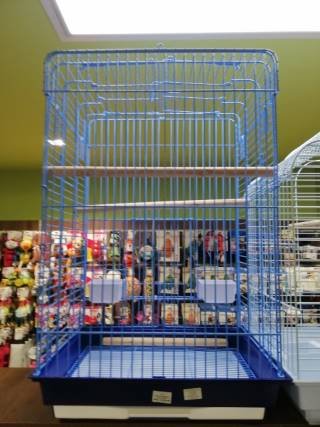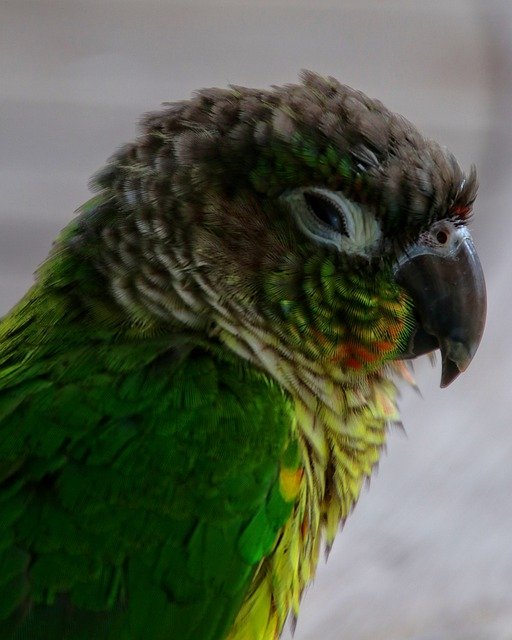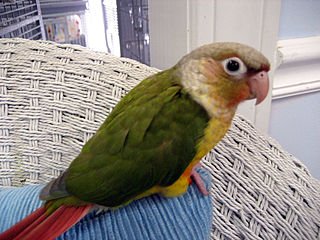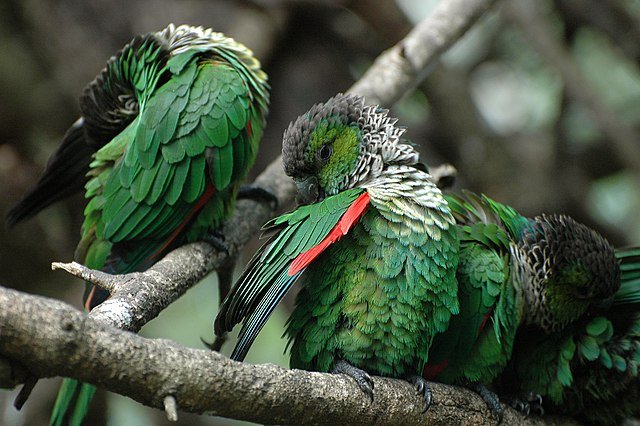Playful and energetic, from Pantanal South American region, Nanday Conures make excellent friends for life. Trendy in look, favored by anyone from families to bird show hosts, they would amaze you with their intelligence. Nanday Conures are a good pet option for both beginner and the experienced keeper. Keep on reading to see if they are suitable for you, as they would surely like to be your chatting buddy for the rest of your life.
Nanday Conure Habitat
Nanday Conure’s Native habitats spread over South America in the Pantanal region. This is the largest tropical wetland and includes areas such as Argentina, Bolivia, Brazil, and Paraguay. On the other hand, a lot of colonies were created in North America in areas such as Florida, Los Angeles, and San Antoni. These colonies are, as it is believed, probably made of pet Conures released or escaped to the wild. Nandays inhabit a range of areas- savannah, palm groves, dry scrublands, forests, and thickets. Consequently, they are adaptable to various living conditions.
Nanday Conure Origin Explained!
Nanday Conures are members of Aratinga Genus. This is a parrot group that belongs to the Arini tribe. They are native to the Americas. They fall into, as all the Parakeets, into the long-tailed group within the Arini tribe. Birds with these roots are often kept as pets. The royal origin gives Nanday Conures most of their advantages- beautiful, social, and intelligent.
Nanday Conure Name
This bird’s common name is Black Hooded Conure. As soon as you see them, you would understand. They have a black face and beak, which looks like a stylish black hood. Name Nanday comes from indigenous language, and it means ‘’bird’’.
Nanday Conure Lifespan
If you want to make a lifelong companion, you are in the right place. Nanday Conures can live up to 40 years. You do need to put some effort into their lifestyle. But, if given optimal conditions, you can both enjoy their longevity.
Nanday Conure Size
Nanday Conures are considered medium-sized birds. They are up to 37 centimeters long. As of weight, they are around 140 to 147 grams on average.
Nanday Conure Color
Nanday’s distinct point is a black collar they proudly carry. The dark, black, face is their most distinguishing feature. Bodies are dominantly olive green or green, with a light-blue mark on the chest. Tail feathers are blue, with dark color underneath each of them. They have red spots on their legs and red inner tights. White rings around eyes make a striking contrast. Overall, these birds have such a trendy look and it is hard to keep one’s eyes off of them.
Nanday Conure Talking ability
Conures are not the family famous for the speech, although it varies among species. Nanday Conures are one of the members with quiet good talking abilities. They Can learn some phrases and build excellent vocabulary which may include around 20 words. Nandays are chatters of their family and would surely become talkers of yours if you give them some attention. Moreover, their voice is very comical, as it sounds like a cartoon character. Chit-chat with a pet doesn’t sound bad after all, right?
They can learn to mimic the sounds from their environment. Although Conures generally don’t pride themselves in a clear voice, you can easily understand what your Nanday is saying.
Are Nanday Conure Loud?
Nandays are not quiet. They are one of the noisiest birds out there. But, it is nothing that adequate socialization cannot beat. Some of them have those natural screams or loud voicing habits that they usually produce in the early morning and afternoon. It is an instinct of the species. Calls are given in order to maintain the flock contact in the wild.
You should take their vocal nature into account when deciding on a new pet. Nandays are talkative if there is a person or another bird companion to talk to. Good training can help combat their screaming habit. If you start early, you can achieve greater results. But, have in mind that, just as with kids, it may take a bit of time to teach the right behavior. Jenday Conures are recommended as quieter alternatives to those whose households cannot tolerate the noise.
Nanday Conure Intelligence
One of the most intelligent species in the Conures family, Nandays are extremely smart and curious. They love to explore the environment and entertain all around. Their intelligence makes it easy to train them, as they can learn faster. On the other hand, curiosity would drive them to exhibit the borders, so be persistent.
Nanday Conure Personality and Behavior
Goofy and silly, Nandays are full of positive energy. They are famous for their extremely social character. From their natural environment, Nandays bring this trait. Usually, they live and move in flocks of 10. That’s why they are outgoing and they like to talk, making friends all around. Another famous characteristic is affinity to bonding. They tie easily to their owners and like to have their affection. But, on the other hand, they don’t require too much petting.
When they get sleepy, in moderation, Nandays enjoy gentle touch. If denied attention in form of talk or freedom, they can be mischievous in the name of fun.
They have strong beaks and that’s why they may not be suitable for families with small children. Also, their voicing habits prevent some from choosing these birds. However, with a slight effort, Nandays make great contributors to family spirit.
A common activity is sleeping on their back. With the back on the floor and legs in the air, it’s like they are playing dead, which is funny to look at.
Nanday Conure Care
Nanday Conure Exercise and Training
Nanday Conures are energetic birds. Exercise is important to release extra spirit they produce daily. It’s essential for their physical, mental, and behavioral plan. Nanday’s need a minimum of 4 hours a day out of the cage. Have in mind that they depend on your dedication. A few hours a day interacting with the bird is necessary.
They need toys to boost their mental plan. Chewing is a favorite activity of Conures, that’s why they need plenty of toys. Favorites are ropes, chewable, and wooden toys.
Nandays Can pick up new tricks easily since they like repetitive behavior. Especially with positive reinforcement, you can teach them everything from simple to breath-taking tricks. These parrots are common attractions in bird shows, as their playful character allows them to enjoy performing tricks.
One of the most famous is a dollar trick, where they take a bill from one person and return it to the same one in the audience. Just looking at them flying is astonishing, and attractive to the audience. They have a swift and direct flight, rapid wingbeats.
However, training should be taken seriously from a young age. If they grow up untrained, they become hard to control.
Nanday Conure Cage
In nature, Nanday Conures inhabit hollows of trees. This is because they like to be safe. However, in the wild, they can fly and stretch whenever they want to. Their size may fit in small space, but personality does require a vast home. Take the wingspan as a reference. At least, they need to be able to spread their wings comfortably.

If you keep one, the recommended minimum size is 20 x 20 x 36 inches, but the bigger the better. It’s not advised to keep a single Nanday Conure. Extremely social, they love to have friends around. And, at the end of the day, it would be way easier for you, because they pay attention to one another. In case you keep a pair, try to find the cage large enough to support them. Don’t underestimate its importance. A good home would bring a good life.
Breeding Nanday Conures
Their clutch consists of 3 to 4 eggs that incubate 24 to 26 days. A year, they have two to three successful clutches. The chicks fledge 8 weeks after hatching. Youngs become independent at two to three weeks of age. After they bring up the babies, Nanday creates roosts until the next season.
When do Nanday Conures reach sexual maturity?
Nanday Conures reach sexually mature when 3 years old. This is a bit later than most of the Conures. Although there were some successful breeding cases in an earlier age, try not to expose them to it as it may be fatal to the bird.
How do I know whether my Nanday Conure is male or female?
Nanday Conures are another monomorphic species of parrots. It means you can not tell the gender just by looking at them, or at least not accurately. Females do tend to be a bit smaller in size, but that cannot be taken as a reference. The only reliable way to distinguish the difference is DNA tests or surgical procedures.
How to distinguish youngs?
Immature birds are recognized as they have less blue on their breast, along with a shorter tail compared to the older individuals. The age can be told through the color of their hood. If the edges are rough and brown colored, then the bird is over a year old.
Nanday Conure Nesting
Nanday Conure usually nests in tree cavities. They prepare nest some weeks before laying. Both partners participate, while females take over the final work. That’s how they do it outside. In captivity, if your space supports it, it’s advised to offer a couple of different nesting boxes and let them choose.
The dimensions are average, but it is strongly influenced by the bird’s preference. Some species of conures have that almost inborn taste for the nesting box, as they long for one similar to the nest where they are born and rared. Around 16 to 24 inches is the average supported size. Keep a lid and a whole, as they generally do allow inspections. Put more of the nest material inside, as they would likely try to remove it, as the effect of their primordial behavior. It’s not particularly beneficial for eggs, so provide more of the material to avoid any damage.
Nanday Conure Health Issues
There are some ailments Conures are susceptible to. Those include Conure Bleeding Syndrom, Pacheco’s disease, and Respiratory problems. However, they have a good immune system and health. Within optimal conditions, Nandays can live a quality life. Keep temperature and moisture under control, provide enough sunlight, and nutritious diet, so you do not have to worry about your Conure getting sick.
You should keep an eye on depression. When they don’t socialize enough, they start feather plucking and screaming. Make sure to provide exercise and freedom they need for optimal mental and physical health.
Nanday Conure Diet
You can offer your Nanday the unlimited palettes of seeds, as they will only eat what they need. They need basic seeds like sunflower, millet, milo, and oats. Palettes are essential, but not enough. Give ¼ of a cup of veggies twice a day. Grapes, apples, carrots, orange, banana, and tomato are favored by birds. Include kale, broccoli, cabbage, and spinach as these are sources of calcium, a vital nutrient for parrot’s development. The lean meat, fish, and eggs should be given occasionally because they are rich in protein.
Avocado, chocolate, coffee, or salty food is harmful and should be avoided.
Do Nanday Conure like Bathing?
What is the Nanday Conure’s greatest source of pleasure? Well, believe it or not, they are overly joyed when bathing. For their health and satisfaction, find a bathing dish and provide fresh water daily.
Are Nanday Conures endangered?
As they make good pets, Nanday conures are prone to the pet trade. People like to take them out of their natural habitat. Nandays adapt easily, so they are one of the preferred species. An example demonstrating the hardiness of the population is that some are found far north in Canada. Despite it, they are still abundant in the wild.
EOL.org status: Least concern
Nanday Conure Price and Purchase
The price for Nandy Conure falls in the average range of 400$ to 600$. It is for the bird only. Cage, toys, food, or taking them to the vet does bring additional costs that should be considered beforehand.
When taking the bird from the breeder, make sure to spend a bit of time with them. It’s important to check on the breeder as well. Anyway, you should see whether your potential new friend is healthy. If they are so, they will have bright eyes, clean feathers, and full crops. Regularly, they are alert and active.
Another task to do is to check with institutions whether keeping Nanday Conure is allowed by the local laws. In some areas, they are considered invasive.
Why are Nanday Conures considered invasive?
From the locals’ point of view, some birds may represent a burden. They are attracted to fruits and seeds, exotic trees, or vegetables. Therefore, farmland owners may not be happy to host them. Nanday conures are not seen as particularly destructive, but without human taming, they could be naughty or exabit aggressive behavior towards humans. It is not surprising though. Animals and humans are afraid of each other on first interactions. As mentioned, Nanday Conures have a strong beak, so they can harm locals if irritated.
From the ecologist’s standpoint, Nanday Conures, or any other non-native bird, represent the threat to the ecosystem. They would be competing with one another. Nandays are medium-sized, but there are many smaller songbirds for instance that they would threaten. For food or shelter, With evolution, this could cause some issues. Conures could fight their position easily, causing shifts in the eco setting of the area.
To the Koet website,Kimball Garrett, the ornithology collections manager of the Natural History Museum of Los Angeles, aid: ‘’Originally from temperate Argentina, the bird was introduced to parts of the United States via the pet trade. It is now expanding its range. It has caused problems in Florida, where the birds’ habit of building giant communal nests atop electrical towers and telephone poles has damaged the region’s power infrastructure.’’
There is still a lot of debate on the actual harmfulness of these birds to the society. Nevertheless, have in mind that they can unwanted by some, so keep your bird to your home. Train them, love them, and they would never need another home.
To sum it all up
If you would like to reflect on what you learned about the goofs of the Conure world, we are presenting you with the quick fact checkpoint.
- Nanday Conures are originally from Pantanal tropical wetland, located in South America
- Hance the unique look, they are commonly called Black Hooded Conures
- Medium-sized
- They are extremely social and intelligent
- Can obtain quiet impressive vocabulary
- Hardy birds due to the harsh native habitat
- Need to be trained to control distinctive vocalization
- In some states, they are considered invasive
- Nanday Conures are great as pets




